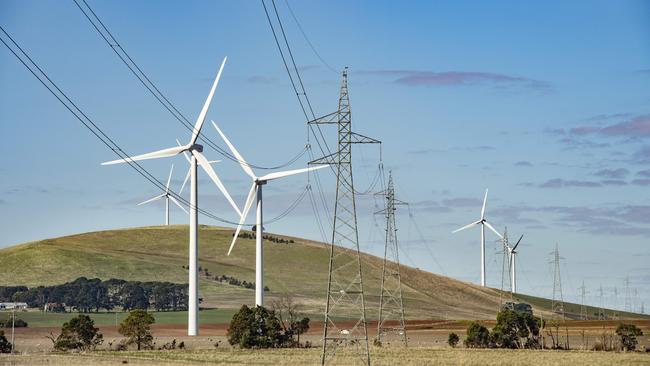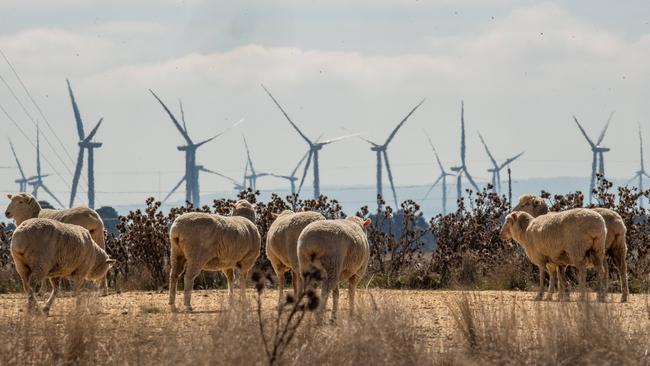
Absent any zealous devotion to net zero by 2050, and recognising that the world’s top emitters are not on board – think here particularly China, but there are others – it’s hard to warm to the vision of Alan Finkel, former chief scientist. “Think forests of wind farms carpeting hills and cliffs from sea to sky. Think endless arrays of solar panels disappearing like a mirage into the desert. What we have now has to be scaled up by a factor of 20.”
While we might forgive him for his flowery prose – he is a scientist, after all – the harsh reality is that many of us are not keen to see our landscapes plundered and ruined by the intrusion of monstrous turbines measuring up to 250 metres in height (nearly three times the height of the Statue of Liberty) and fields of unattractive solar panels generating unwanted ambient heat for the surrounding district.
Would the residents of the seats of Kooyong, Warringah or Wentworth be happy to have their parks, empty land and adjoining water ways – perhaps some big backyards? – handed over to mainly overseas-owned renewable energy developers to construct intrusive and sometimes noisy installations in the quest of decarbonisation?

We all know the answer to that question. But the members for these seats (and others) are more than happy to impose the external costs on their country cousins and create unfortunate divisions within previously harmonious rural communities.
It is worth going through some facts here because facts are often missing in the emotional debate about saving the planet. The first thing to note is the large amount of land needed to accommodate renewable energy relative to high-energy-density fossil fuels and nuclear energy. For every megawatt hour produced, wind needs seven times more land than coal-fired plants and 10 times more than gas-fired plants, for example.
The second is the low-capacity efficiency of both wind and solar. The average output of wind installations is just over one-third of the nameplate capacities; it’s one-quarter for solar. This is an important point because the proponents of new renewable energy projects often quote the nameplate capacities and then spuriously claim they will power a given number of thousands of homes while ignoring the necessary and costly in-fill and back-up sources of electricity generation.
Another important point is the life cycles of renewable energy installations and how these compare with coal/gas plants and nuclear. The lifespan of onshore turbines ranges from 15 to 25 years; it’s shorter for offshore ones. Solar panels don’t generally last more than 20 years and their efficiency falls every year. There is virtually no scope to recycle either turbines or solar panels, which raises the tricky issue of their ultimate disposal. Coal, gas and nuclear plants can last five decades or longer.
One feature of the renewable energy landscape Finkel missed in his florid description is the kilometre upon kilometre of new transmission lines required to hook up wind and solar installations to the grid. Think here huge steel pylons up to 100 metres in height requiring easements of up to 50 metres on each side.
The point here is that no one would regard these unsightly new transmission lines weaving their way through agricultural land, national parks and regional communities as enhancing the environment. They may also constitute an extra fire risk. For those affected, it is a perfectly rational response to oppose their construction, to seek alternative paths or to advocate for underground transmission.
We know the good burghers of Kooyong, Warringah and Wentworth would do so. Attempting to bribe those affected with substantial annual annuities – they are currently more than $200,000 per kilometre – runs the risk of dividing communities as those who miss out on any compensation can still be adversely impacted.
The potential environmental damage caused by renewable energy projects has been highlighted by number of recent cases. A proposed wind farm north of Port Fairy in western Victoria has been approved subject to strict restrictions, including reducing the number of turbines from 59 to 18. This is because of the sensitive nature of the land for nesting brolgas and bent-wing bats. Construction will also be banned from July through to November. In all likelihood, this project will now not proceed.
A wind project on Robbins Island off the northwest coast of Tasmania has been approved to operate for only seven months of the year because of the threat to the orange-bellied parrots that live on the island. Again, this project is unlikely to go ahead.
Much controversy surrounds the Chalumbin wind farm development in far north Queensland where large tracts of land – up to 1200 hectares – will be cleared adjacent to a World Heritage-listed rainforest, west of Cairns. An earlier small-scale wind farm has resulted in a number of disused turbines simply rusting on the land. It’s hard to square this development with genuine concern for the environment, particularly as there are serious doubts about the windiness of the area.
Just in case you think offshore turbines are the solution to this dilemma, the reality is very different. Turbines as far out as 10 to 15 kilometres from the coast can still be seen from land. Again, the rational response from those who live nearby, including retired sea-changers, is to oppose these developments. Moreover, there is mounting evidence these turbines, which require enormous amounts of concrete to fix them in place, can interfere with marine life, including migrating whales.
The opposition to offshore wind farms may prove to be irrelevant as the economics of these projects massively deteriorate. The large Swedish renewable energy firm, Vattenfall, has recently stopped two major projects – one in the UK – citing higher inflation and capital costs. The huge losses incurred by the wind division of Siemen Energy are also noteworthy. The only way offshore projects will proceed in Australia is if the operators are given even more subsidies than are currently on the table, which will translate into even higher consumer prices.
It is now crunch time for Energy Minister Chris Bowen and a number of state governments. It’s clear the dream of more renewable energy, lower emissions and lower electricity prices is unattainable, if it ever was. The ditching of the Marinus Link between Tasmania and Victoria has finally put paid to the vision of the Apple Isle being the battery of the nation; indeed, it is now running short of power itself.
Plan B can’t come quickly enough, including the nuclear option – think of the environment.







It is slowly dawning on more people that destroying the environment to save the environment doesn’t really make any sense. The people living in rural and regional Australia have known this for some time, but more city folk are waking up to the fact that the process of decarbonisation imposes some hefty costs that are not evenly distributed.